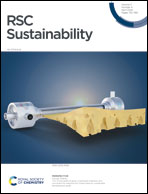Tailoring lignin nanoparticle properties: the effects of pH and salt on shape and antioxidant capacity†
Abstract
In this study we explore the extent to which we can tune lignin nanoparticles produced in a biorefinery that couples a microbial electrolysis cell to lignin depolymerization. We vary the salt type and pH and monitor the size and shape of the nanoparticles, as well as the antioxidant capacity of the mixture. We found that the salt type influences the shape of the lignin nanoparticles – ranging from spherical (phosphate) to rod-like (nitrate and chloride) and flower-like (carbonate). Additionally, the shape and the size influence the antioxidant capacity due to changes in the surface area to volume ratio. The flower-like nanoparticles have a high surface area to volume ratio and the highest antioxidant capacity, which is similar to that of the industrial benchmark antioxidant, Trolox. The antioxidant capacity of the lignin nanoparticles illustrates their high potential value in the pharmaceutical, nutraceutical, personal care, and agricultural industries.



 Please wait while we load your content...
Please wait while we load your content...